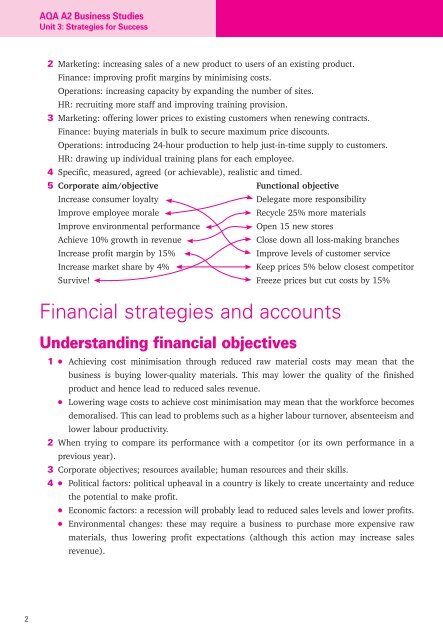A2 Business Studies Unit 3 Strategies for Success AQA
A2 Business Studies Unit 3 Strategies for Success AQA
A2 Business Studies Unit 3 Strategies for Success AQA
- No tags were found...
Create successful ePaper yourself
Turn your PDF publications into a flip-book with our unique Google optimized e-Paper software.
<strong>AQA</strong> <strong>A2</strong> <strong>Business</strong> <strong>Studies</strong><strong>Unit</strong> 3: <strong>Strategies</strong> <strong>for</strong> <strong>Success</strong>2 Marketing: increasing sales of a new product to users of an existing product.Finance: improving profit margins by minimising costs.Operations: increasing capacity by expanding the number of sites.HR: recruiting more staff and improving training provision.3 Marketing: offering lower prices to existing customers when renewing contracts.Finance: buying materials in bulk to secure maximum price discounts.Operations: introducing 24-hour production to help just-in-time supply to customers.HR: drawing up individual training plans <strong>for</strong> each employee.4 Specific, measured, agreed (or achievable), realistic and timed.5 Corporate aim/objective Functional objectiveIncrease consumer loyaltyDelegate more responsibilityImprove employee moraleRecycle 25% more materialsImprove environmental per<strong>for</strong>manceOpen 15 new storesAchieve 10% growth in revenueClose down all loss-making branchesIncrease profit margin by 15%Improve levels of customer serviceIncrease market share by 4%Keep prices 5% below closest competitorSurvive! Freeze prices but cut costs by 15%Financial strategies and accountsUnderstanding financial objectives1 ● Achieving cost minimisation through reduced raw material costs may mean that thebusiness is buying lower-quality materials. This may lower the quality of the finishedproduct and hence lead to reduced sales revenue.● Lowering wage costs to achieve cost minimisation may mean that the work<strong>for</strong>ce becomesdemoralised. This can lead to problems such as a higher labour turnover, absenteeism andlower labour productivity.2 When trying to compare its per<strong>for</strong>mance with a competitor (or its own per<strong>for</strong>mance in aprevious year).3 Corporate objectives; resources available; human resources and their skills.4 ● Political factors: political upheaval in a country is likely to create uncertainty and reducethe potential to make profit.● Economic factors: a recession will probably lead to reduced sales levels and lower profits.● Environmental changes: these may require a business to purchase more expensive rawmaterials, thus lowering profit expectations (although this action may increase salesrevenue).2
















